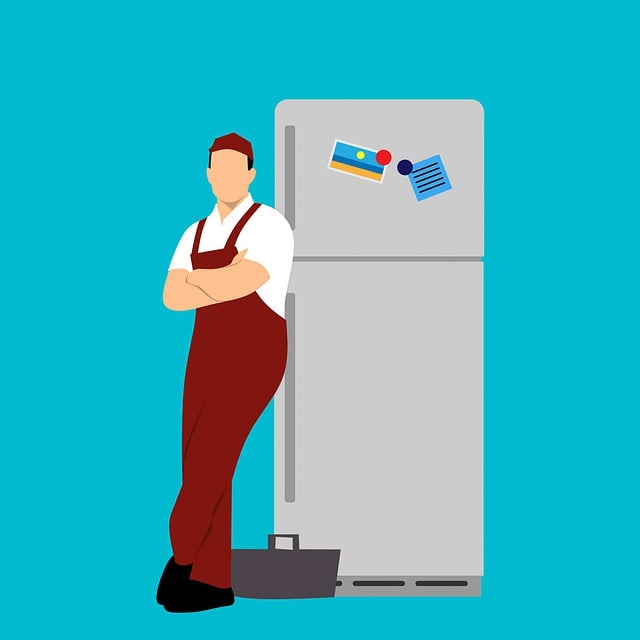Refrigerator repair services often encounter issues with aging or obsolescent refrigerator thermostats that can cause inconsistent cooling, which may lead to food spoilage and inefficient appliance performance. To maintain precise temperature settings, experts recommend replacing the thermostat for better stability. Upgrading to a newer model thermostat not only enhances the reliability and consistency of your refrigerator's operation but also extends its lifespan and ensures optimal energy usage. For homes with outdated thermostats, especially those over ten years old, upgrading to a programmable or smart thermostat is highly beneficial for improved temperature control, convenience, and potential energy savings. These modern thermostats are designed to adapt to your usage patterns and offer seamless compatibility with refrigerator repair and HVAC system advancements. Installation of a new thermostat involves selecting the appropriate type, preparing the installation site, securely reconnecting wires according to manufacturer's guidelines, and configuring settings for enhanced comfort and energy savings. After installation, it's crucial to calibrate and test the thermostat for precise temperature readings, ensuring its sensors are free from obstructions and that it has stabilized in the ambient conditions of your home. Regular maintenance and occasional checks are essential for maintaining the thermostat's accuracy and the efficiency of your home's climate control system.
When precision temperature control is key for comfort and efficiency, considering a thermostat replacement can be a pivotal decision. Whether it’s your home or business, an accurate thermostat is crucial for optimal climate management. This article delves into the importance of recognizing when to upgrade your thermostat and walks you through the installation process. With expert guidance on selecting and fitting a new model, you can rest assured that your refrigerator repair needs and overall temperature control will be significantly enhanced post-installation. Dive into the nuances of maintaining the perfect ambiance with our comprehensive guide on thermostat replacements.
- Understanding the Necessity of a Thermostat Replacement for Precision Temperature Control
- Signs Indicating It's Time to Replace Your Thermostat
- The Process of Installing a New Thermostat in Your Residential or Commercial Space
- Post-Installation: Ensuring Your New Thermostat Delivers Accurate Temperature Readings and Optimal Performance
Understanding the Necessity of a Thermostat Replacement for Precision Temperature Control

When a refrigerator’s thermostat malfunctions or becomes outdated, precision temperature control is compromised. This can lead to inconsistent cooling, which may result in food spoiling prematurely or the fridge operating less efficiently than optimal. Over time, the accuracy of a thermostat can degrade due to wear and tear, environmental factors, or simply because of technological advancements that render older models less precise. Recognizing this, refrigerator repair services often recommend thermostat replacement as a solution for enhanced temperature stability within your appliance. By upgrading to a newer model thermostat, homeowners can expect a more reliable and consistent performance from their refrigerator, ensuring that food is stored safely and energy consumption is optimized. This not only extends the lifespan of the refrigerator but also contributes to better preservation of your perishables, which is crucial for both safety and convenience. When considering the frequency of thermostat replacement, it’s advisable to adhere to the manufacturer’s guidelines or consult with a professional in refrigerator repair to ensure that your unit is functioning at its best. Regular maintenance and timely thermostat upgrades can prevent more costly repairs down the line, making the investment in a new thermostat a wise decision for those looking to maintain accurate temperature control in their household appliances.
Signs Indicating It's Time to Replace Your Thermostat

When your thermostat consistently provides inaccurate temperature readings, it’s a clear sign that its sensors may have malfunctioned over time. This can lead to discomfort and improper heating or cooling of your living space. Additionally, if you notice that your energy bills are higher than usual for no apparent reason, an outdated thermostat might be struggling to maintain the set temperatures efficiently. In such cases, investing in a new thermostat, which often includes programmable and smart options, can lead to better temperature control and potentially lower utility costs. Modern thermostats offer advanced features that learn your habits and adjust the climate accordingly, ensuring consistent comfort. Moreover, if your current thermostat is over a decade old, it might be time for an upgrade. Technological advancements in thermostats have significantly improved their accuracy and functionality. By replacing an older model with a newer, more precise one, you can ensure that your home’s environment aligns with your preferences, providing a more comfortable and energy-efficient living space.
Another indicator that it’s time to replace your thermostat is if it is no longer compatible with your refrigerator repair needs or other HVAC system upgrades. Outdated thermostats may not support new systems or may require additional modifications to integrate with modern appliances. This can complicate repairs and maintenance, potentially leading to further inefficiencies and costs. By selecting a new thermostat that is designed to work seamlessly with current refrigerator repair standards and HVAC technologies, you can simplify future repairs and enhance the overall functionality of your home’s systems.
The Process of Installing a New Thermostat in Your Residential or Commercial Space

When the time comes to upgrade your thermostat for enhanced temperature control, it’s a straightforward process that can be executed by a qualified professional or, if you have the necessary skills, as a DIY project. The first step in installing a new thermostat is choosing the right model for your residential or commercial space. There are various types available, including programmable, smart, and manual options. Once you’ve selected a compatible thermostat that suits your needs, you can proceed with the installation. This involves turning off power to the existing thermostat to ensure safety during handling and replacement. Next, remove the old thermostat by carefully detaching wires and dismantling the device from the wall plate.
Prepare the site by cleaning the area where the new thermostat will be installed to remove any dust or debris that could interfere with its functionality. Installation continues with marking the location of wires on the wall behind the old thermostat for reference. Then, attach the new thermostat to the wall plate and connect the wires according to the manufacturer’s instructions. Ensure that all connections are secure and that the device is positioned at a suitable height for easy access and reading. Once installed, power can be restored, and you can proceed to configure your new thermostat’s settings. This may involve setting up schedules if it’s a programmable model or connecting it to your Wi-Fi network if it’s a smart thermostat, allowing for remote monitoring and control. Such an upgrade not only enhances the precision of your indoor climate control but can also contribute to energy savings and improved comfort in your living or working environment. If you encounter issues such as refrigerator repair needs or other HVAC malfunctions during this process, it’s advisable to consult a professional technician for assistance. Regular maintenance and timely thermostat replacement are key to maintaining optimal temperature control in any setting.
Post-Installation: Ensuring Your New Thermostat Delivers Accurate Temperature Readings and Optimal Performance

Following the installation of a new thermostat, it is crucial to calibrate and test it to ensure accurate temperature readings and optimal performance. Begin by removing any protective coverings or packaging that may have interfered with the thermostat’s sensors during transport or installation. Place the thermostat in a location that reflects typical usage patterns, away from direct sunlight, drafts, or heat sources like a refrigerator, which could skew temperature readings.
Once positioned correctly, allow the thermostat to acclimate to the room’s ambient temperature for at least 24 hours before making any adjustments. This period enables the internal components to stabilize and provides a baseline for accurate readings. After this acclimation period, verify the settings against the manufacturer’s specifications or your previous thermostat’s readings for comparison. If discrepancies are found, recalibrate the thermostat according to the user manual’s instructions. It is also advisable to test the thermostat’s responsiveness by adjusting the temperature settings and monitoring how quickly and accurately the thermostat responds. If you encounter any issues with your new thermostat, such as inaccurate readings or poor performance, it may be necessary to consult a professional for further troubleshooting or to confirm that your installation was completed correctly. Regular maintenance and occasional checks can help maintain the accuracy of your thermostat over time, ensuring that your home’s climate control system operates efficiently and effectively.
In conclusion, maintaining precise temperature control is paramount for both comfort and energy efficiency within any living or working environment. When a thermostat malfunctions or becomes outdated, it can significantly impact your ability to regulate temperature accurately. Recognizing the telltale signs that signify the need for thermostat replacement is crucial, followed by a professional installation process tailored to your specific setting. Post-installation care ensures your new thermostat operates at its best, delivering reliable and accurate temperature readings. Remember, this not only enhances your overall experience but also aligns with broader sustainability goals. For those facing issues with their refrigerator or other cooling appliances, seeking expert refrigerator repair services can complement the effectiveness of your temperature control systems. With these steps in place, you can rest assured that your thermostat will serve as a reliable tool for years to come.
